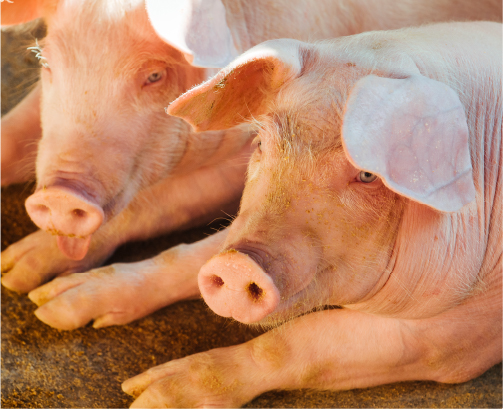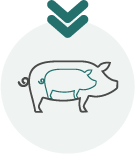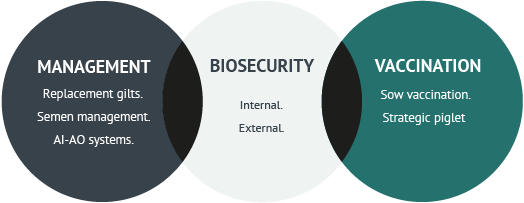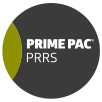
PRRS
Disease
Porcine Reproductive and Respiratory Syndrome is one of the top 5 major diseases in swine production and one of the most significant health risks for pigs worldwide. PRRS is caused by an arterivirus. Interferes with the immune system and up to a 40% of macrophages, which eliminates most of the animal’s defense mechanisms and allows bacteria and other virus to proliferate and damage the respiratory system predisposing the pigs to suffer other infections (PRRSV acts as an enhancing factor for them), and worsening the clinical presentation of disease.
The virus can cross the placenta and infect fetuses from 70 days of pregnancy, causing abortions in the third trimester and mummies, still- or weakborn. Gilts and sows infected with the PRRS virus (PRRSV) can become chronically under-productive, with increased fetal morbidity and mortality.
Surviving progeny can be more prone to respiratory tract infections and associated growth problems. All these clinical signs vary markedly between herds depending on the virulence of the virus and the immune status of the pigs.
PRRSV is transferred via aerosols, air and body fluids, meaning it is easily spread through a herd.1

Economic impact
PRRS can have a significant economic impact through:

Reduced average
daily weight gain

Reduced
feed efficiency

Increased
mortality
PRRS may reduce the annual productivity of the herd by 15%
The economic impact of PRRSV circulation is estimated as 185 €/sow or 3.73 €/pig sold.2
The total cost of productivity losses due to PRRSV in the US national breeding and growing-pig herd was estimated at US $664 million annually in 2011 (US $1.8 million per day).3
On a per-pig basis, PPRSV costs the industry $4.67 per every pig marketed in the US (even US $5.57 per head placed).4
In Europe, the mean total loss attributable to PRRS was estimated to be 255€ per sow and year (in breeding herds, it may result in an average loss of 1.7 sold feeder pigs and €296 per sow).
- The impact of PRRS on European farm profit was -19.1% on average and -41% in the worst case.
- In growing pigs, an increase of 14 to 30 days to market in the finishing stage, adding US $7.50 to $15.00 to the cost of each pig marketed has been estimated.

Prevalence
Studies have shown the PRRSv infection has become endemic in nearly all the main swine producing areas of the world.
They are the 2 recognized PRRSV species: PRRSV1 and PRRSV2.
Both species are disseminated worldwide, however PRRSV1 is actually predominant in Europe while PRRSV2 is the most prevalent in America and Asia has a mix of both.
The PRRSV has an extremely high mutation rate and new strains of the virus are constantly emerging, corresponding to the mentioned wide range of clinical presentations on swine farms and producing new outbreaks through the world.

Diagnosis
This is based on the clinical signs, postmortem examinations and the known presence of the virus by PCR (It can be performed from different sample types, including tissue samples, oral fluids, swabs from the respiratory tract, semen, etc.).
There are several tests available, but ELISA is the standard test used. Currently, oral fluids are used to monitor farms, but serology is not a valid approach for a diagnosis of PRRS in previously infected or vaccinated herds, because current assays cannot differentiate among antibodies resulting from an initial infection, reinfection, or vaccination. Antibody titers are also not predictive of this.
Clinical signs are very variable depending on the strain.
PRRSv 2 strains tend to be clinically more severe.
Clinical signs of PRRS with supportive gross lesions and clinical history can suggest PRRS, but any tentative clinical diagnosis should be confirmed using laboratory methods.
Clinical signs include:
- Chemosis (puffy eyes).
- Less viable piglets and increase of respiratory infections in piglets due to Co-infections.
- Letargy, inapetence.
- Moderate coughing, sneezing.
- Reproductive issues (such as premature farrowing, increase in returns, longer anestrus, delayed returns to estrus, increased stillborn levels, foetal morbidity).
- Fever, anorexia and late-term abortions in sows.
- Increase in overall mortality.

Treatment and prevention
Controlling and keeping PRRSV under control is only possible through a structured action plan tailored to individual farms.
PRRS control programs:
- Effective prevention and control require a combination of biosecurity measures, proper management, and vaccination.
- The main goals are based on avoiding the entry of new PRRSV strains, minimizing virus transmission and circulation in the farm, maximizing the herd immunity against PRRSV and limiting the losses due to secondary infections.
Eradication of PRRSV is possible by implementing different management procedures such as whole herd depopulation – repopulation or herd closure, test and removal under vaccination.
BIOSECURITY:
However, PRRSV eradication should only be considered if location and biosecurity measures are good enough to prevent subsequent re-infections.
Controlling PRRS: a multi-factorial approach
Controlling PRRS is a journey with several important stops:

1. Pileri E and Mateu E. Review on the transmission porcine reproductive and respiratory syndrome virus between pigs and farms and impact on vaccination. Vet Res. 2016;47: 108.
2. Normand V. et al., Economic impact of PRRSV stabilization following intradermal mass-vaccination (Porcilis® PRRS) and strict biosecurity measures. IPVS 2014.
3. Holtkamp D. et al., Assessment of the economic impact of porcine reproductive and respiratory syndrome virus on United States pork producers. Journal of Swine Health and Production, 2013.
4. Haden C. et al., 2012 AASV Annual Meeting, 75-7.
Used in conjunction with our vaccines to provide comprehensive protection against PRRSv, MSD AH has developed a set of additional knowledge on all areas PRRS-related.
Download the disease infographic
MSD Animal Health solutions to control PRRS

Porcilis® PRRS
ResPig: Porcilis® PRRS is a live, attenuated, freeze-dried vaccine that protects pigs against infection with Porcine Reproductive and Respiratory Syndrome type I with a simple, single dose. Also available on intradermal vaccine (see more details below).
SOLUTIONS
Porcilis® PRRS
Attenuated live vaccine
against PRRS


Onset of immunity: 4 weeks after vaccination
Duration of immunity: 24 weeks after vaccination.
BENEFITS
- Reduces the economic loss in finishing pigs.
- Improves reproductive performance in breeding pigs.
- Vaccinating both piglets and sows maximises protection for the whole herd.
HOW TO USE IT
- Piglets: A single 2ml dose intramuscularly or 0.2 ml dose intradermally (ID) at two weeks of age onwards.
- Gilts and Sows: A vaccination 2-4 weeks before mating is recommended.
- Intramusculary it can be given concomitantly with Porcilis PCV M Hyo (the latter mixed or not with Porcilis Lawsonia).
Available in EU and APSA.

The IDAL Way: Porcilis® PRRS
Porcilis® PRRS is a live, attenuated, freeze-dried vaccine that protects pigs against infection with Porcine Reproductive and Respiratory Syndrome type I with a simple, single dose.

The IDAL Way: Prime Pac® PRRS
Prime Pac® PRRS is a live, attenuated, freeze-dried vaccine that protects pigs against infection with Porcine Reproductive and Respiratory Syndrome type II with a simple, single dose.
SOLUTIONS
PrimePac® PRRS
Attenuated live vaccine
against PRRS Type 2


Onset of immunity: 4 weeks after vaccination.
Duration of immunity: 23 weeks after vaccination.
BENEFITS
- Reduces viremia and clinical signs caused by infection with PRRS virus.
- Improves reproductive performance in breeding pigs.
HOW TO USE IT
- Piglets: A single 1ml dose intramuscularly or 0.2 ml dose intradermally at two weeks of age onwards.
- Breeding pigs: For gilts and sows a vaccination 2-4 weeks before mating is recommended.
Available in LATAM and APSA. Prime Pac PRRS RR (intramuscular) is available in NA.





